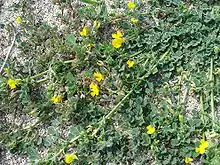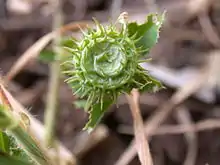Medicago
Medicago is a genus of flowering plants, commonly known as medick or burclover, in the legume family (Fabaceae). It contains at least 87 species and is distributed mainly around the Mediterranean basin.[2][3] The best-known member of the genus is alfalfa (M. sativa), an important forage crop,[4] and the genus name is based on the Latin name for that plant, medica, from Greek: μηδική (πόα) Median (grass).[5] Most members of the genus are low, creeping herbs, resembling clover, but with burs (hence the common name). However, alfalfa grows to a height of 1 meter, and tree medick (M. arborea) is a shrub. Members of the genus are known to produce bioactive compounds such as medicarpin (a flavonoid) and medicagenic acid (a triterpenoid saponin).[3] Chromosome numbers in Medicago range from 2n = 14 to 48.[6]
| Medicago | |
|---|---|
 | |
| Medicago littoralis | |
 | |
| Medicago granadensis bur | |
| Scientific classification | |
| Kingdom: | Plantae |
| Clade: | Tracheophytes |
| Clade: | Angiosperms |
| Clade: | Eudicots |
| Clade: | Rosids |
| Order: | Fabales |
| Family: | Fabaceae |
| Tribe: | Trifolieae |
| Genus: | Medicago L. |
| Type species | |
| Medicago sativa | |
| Species | |
|
87–105; see text. | |
| Synonyms[1] | |
| |
The species Medicago truncatula is a model legume[7] due to its relatively small stature, small genome (450–500 Mbp), short generation time (about 3 months), and ability to reproduce both by outcrossing and selfing.
Comprehensive descriptions of the genus are Lesinš and Lesinš 1979[8] and Small and Jomphe 1989.[9] Major collections are SARDI (Australia),[10] USDA-GRIN (United States),[11] ICARDA (Syria),[12] and INRA (France).[13]
Evolution
Medicago diverged from Glycine (soybean) about 53–55 million years ago (in the early Eocene),[14] from Lotus (deervetch) 49–51 million years ago (also in the Eocene),[14] and from Trigonella 10–22 million years ago (in the Miocene).[15]
Ecological interactions with other organisms
Symbiosis with nitrogen-fixing rhizobia
Béna et al. (2005) constructed a molecular phylogeny of 23 Sinorhizobium strains and tested the symbiotic ability of six strains with 35 Medicago species.[16] Comparison of these phylogenies indicates many transitions in the compatibility of the association over evolutionary time. Furthermore, they propose that the geographical distribution of strains limits the distribution of particular Medicago species.
Agricultural uses
Other than alfalfa, several of the creeping members of the family (such as Medicago lupulina and Medicago truncatula) have been used as forage crops.[17]
| Wikimedia Commons has media related to Medicago. |
| Wikispecies has information related to Medicago. |
Insect herbivores
Medicago species are used as food plants by the larvae of some Lepidoptera species including the common swift, flame, latticed heath, lime-speck pug, nutmeg, setaceous Hebrew character, and turnip moths and case-bearers of the genus Coleophora, including C. frischella (recorded on M. sativa) and C. fuscociliella (feeds exclusively on Medicago spp.).
Species
This list is compiled from:[9][18][19][20][21][22][23][24][25][26][27]
Section Buceras
Subsection Deflexae
- Medicago retrorsa (Boiss.) E. Small
Subsection Erectae
- Medicago arenicola (Huber-Mor.) E. Small
- Medicago astroites (Fisch. & Mey.) Trautv.
- Medicago carica (Huber-Mor.) E. Small
- Medicago crassipes (Boiss.) E. Small
- Medicago fischeriana (Ser.) Trautv.
- Medicago halophila (Boiss.) E. Small
- Medicago heldreichii (Boiss.) E. Small
- Medicago medicaginoides (Retz.) E. Small
- Medicago monantha (C. A. Meyer) Trautv.
- Medicago orthoceras (Kar. & Kir.) Trautv.
- Medicago pamphylica (Huber-Mor. & Sirjaev) E. Small
- Medicago persica (Boiss.) E. Small
- Medicago phrygia (Boiss. & Bal.) E. Small
- Medicago polyceratia (L.) Trautv.
- Medicago rigida (Boiss. & Bal.) E. Small
Subsection Isthmocarpae
- Medicago rhytidiocarpa (Boiss. & Bal.) E. Small
- Medicago isthmocarpa (Boiss. & Bal.) E. Small
Subsection Reflexae
- Medicago monspeliaca (L.) Trautv.
Section Carstiensae
- Medicago carstiensis Wulf.
Section Dendrotelis
- Medicago arborea L.
- Medicago citrina (Font Quer) Greuter[Note 1]
- Medicago strasseri Greuter, Matthas & Risse
Section Geocarpa
- Medicago hypogaea E. Small
Section Heynianae
- Medicago heyniana Greuter
Section Hymenocarpos
Section Lunatae
- Medicago biflora (Griseb.) E. Small
- Medicago brachycarpa M. Bieb.
- Medicago huberi E. Small
- Medicago rostrata (Boiss. & Bal.) E. Small
Section Lupularia
- Medicago lupulina L.
- Medicago secundiflora Durieu
Section Medicago
- Medicago cancellata M. Bieb.
- Medicago daghestanica Rupr.
- Medicago hybrida (Pourr.) Trautv.
- Medicago marina L.
- Medicago papillosa Boiss.
- M. p. macrocarpa
- M. p. papillosa
- Medicago pironae Vis.
- Medicago prostrata Jacq.
- M. p. prostrata
- M. p. pseudorupestris
- Medicago rhodopea Velen.
- Medicago rupestris M. Bieb
- Medicago sativa L. (alfalfa)
- M. s. caerulea
- M. s. falcata (Medicago falcata)
- M. s. f. var. falcata
- M. s. f. var. viscosa
- M. s. glomerata
- M. s. sativa
- Medicago saxatilis M. Bieb
- Medicago suffruticosa Ramond ex DC.
- M. s. leiocarpa
- M. s. suffruticosa
Section Orbiculares
- Medicago orbicularis (L.) Bart.
Section Platycarpae
- Medicago archiducis-nicolai Sirjaev
- Medicago cretacea M. Bieb.
- Medicago edgeworthii Sirjaev
- Medicago ovalis (Boiss.) Sirjaev
- Medicago playtcarpa (L.) Trautv.
- Medicago plicata (Boiss.) Sirjaev
- Medicago popovii (E. Kor.) Sirjaev
- Medicago ruthenica (L.) Ledebour
Subsection Rotatae
- Medicago blancheana Boiss.
- Medicago noeana Boiss.
- Medicago rugosa Desr.
- Medicago rotata Boiss.
- Medicago scutellata (L.) Miller
- Medicago shepardii Post
Section Spirocarpos
Subsection Intertextae
- Medicago ciliaris (L.) Krocker
- Medicago granadensis Willd.
- Medicago intertexta (L.) Miller
- Medicago muricoleptis Tin.
Subsection Leptospireae
- Medicago arabica (L.) Huds.
- Medicago coronata (L.) Bart.
- Medicago disciformis DC.
- Medicago laciniata (L.) Miller
- Medicago lanigera Winkl. & Fedtsch.
- Medicago laxispira Heyn
- Medicago minima (L.) Bart.
- Medicago polymorpha L.
- Medicago praecox DC.
- Medicago sauvagei Nègre
- Medicago tenoreana Ser.
Subsection Pachyspireae
- Medicago constricta Durieu
- Medicago doliata Carmign.
- Medicago italica (Miller) Fiori
- Medicago lesinsii E. Small
- Medicago littoralis Rohde ex Lois.
- Medicago murex Willd.
- Medicago rigidula (L.) All.
- Medicago rigiduloides E. Small
- Medicago sinskiae Uljanova[Note 2]
- Medicago soleirolii Duby
- Medicago sphaerocarpos Bertol.[28]
- Medicago syriaca E. Small
- Medicago truncatula Gaertn.
- Medicago turbinata (L.) All.
Species names with uncertain taxonomic status
The status of the following species is unresolved:[9]
- Medicago agropyretorum Vassilcz.
- Medicago alatavica Vassilcz.
- Medicago caucasica Vassilcz.
- Medicago cyrenaea Maire & Weiller
- Medicago difalcata Sinskaya
- Medicago grossheimii Vassilcz.
- Medicago gunibica Vassilcz.
- Medicago hemicoerulea Sinskaya
- Medicago karatschaica (A. Heller) A. Heller
- Medicago komarovii Vassilcz.
- Medicago meyeri Gruner
- Medicago polychroa Grossh.
- Medicago schischkinii Sumnev.
- Medicago talyschensis Latsch.
- Medicago transoxana Vassilcz.
- Medicago tunetana (Murb.) A.W. Hill
- Medicago vardanis' Vassilcz.
- Medicago virescens Grossh.
Recent molecular phylogenic analyses of Medicago indicate that the sections and subsections defined by Small & Jomphe, as outlined above, are generally polyphyletic.[2][15][16][29][30][31][32][33] However, with minor revisions sections and subsections could be rendered monophyletic.[15][29][30][31][32][33]
Notes
- Some sources treat Medicago citrina as a synonym of Medicago arborea.
- The validity of Medicago sinskiae has been questioned by Small and Jomphe, 1988.[9]
References
- "Genus Nomenclature in GRIN". Retrieved 9 September 2010.
- Steele KP, Ickert-Bond SM, Zarre S, Wojciechowski MF (2010). "Phylogeny and character evolution in Medicago (Leguminosae): Evidence from analyses of plastid trnK/matK and nuclear GA3ox1 sequences". Am J Bot. 97 (7): 1142–1155. doi:10.3732/ajb.1000009. PMID 21616866.
- Gholami A, De Geyter N, Pollier J, Goormachtig S, Goossens A (2014). "Natural product biosynthesis in Medicago species". Natural Product Reports. 31 (3): 356–380. doi:10.1039/C3NP70104B. PMID 24481477.
- "Alfalfa Crop Germplasm Committee Report, 2000". Archived from the original on 2009-05-05. Retrieved 2009-11-04.
- New Oxford American Dictionary (2nd ed., 2005), p. 1054, s.v. medick.
- Rosato M, Galián JA, Rosselló JA (2012). "Amplification, contraction and genomic spread of a satellite DNA family (E180) in Medicago (Fabaceae) and allied genera". Ann Bot. 109 (4): 773–82. doi:10.1093/aob/mcr309. PMC 3286279. PMID 22186276.
- "Medicago truncatula". Archived from the original on 29 December 2008. Retrieved 21 November 2008.
- Lesinš KA, Lesinš I (1979). Genus Medicago (Leguminosae): A Taxogenetic Study. The Hague, The Netherlands: Dr. W. Junk B. V. Publishers. p. 132. ISBN 978-90-6193-598-8.
- Small E, Jomphe M (1989). "A Synopsis of the Genus Medicago (Leguminosae)". Can J Bot. 67 (11): 3260–94. doi:10.1139/b89-405.
- "SARDI". Archived from the original on 26 October 2008. Retrieved 21 November 2008.
- "GRIN National Genetic Resources Program". Retrieved 21 November 2008.
- "ICARDA Sustainable Agriculture for the Dry Areas". Archived from the original on 11 December 2008. Retrieved 21 November 2008.
- "INRA". Archived from the original on 31 July 2010. Retrieved 21 November 2008.
- Cannon S. (2008). "3. Legume Comparative Genomics" (PDF). In Stacey G (ed.). Genetics and Genomics of Soybean. Plant Genetics and Genomics: Crops and Models. II. New York, NY: Springer. p. 38. ISBN 978-0-387-72298-6.
- Maureira Butler IJ, Pfeil BE, Muangprom A, Osborn TC, Doyle JJ (2008). "The reticulate history of Medicago (Fabaceae)". Syst Biol. 57 (6): 466–482. doi:10.1080/10635150802172168. PMID 18570039.
- Béna G, Lyet A, Huguet T, Olivier I (2005). "Medicago–Sinorhizobium symbiotic specificity evolution and the geographic expansion of Medicago". J. Evol. Biol. 18 (6): 1547–58. doi:10.1111/j.1420-9101.2005.00952.x. PMID 16313467. S2CID 24813001.
- Lawson (2001). "Suitability of Medicago clover species as a forage crop: a study of controlled dietary intake on livestock health over time". International Journal of Agricultural Research. 9 (3): 33–44.
- "ILDIS LegumeWeb". Archived from the original on 1999-10-07. Retrieved 2008-11-18.
- "Genera Containing Currently Accepted Names: Medicago". Archived from the original on September 30, 2008. Retrieved 2008-11-18.
- "Species Nomenclature in GRIN". Archived from the original on 1999-05-01. Retrieved 2008-11-18.
- "IPNI Plant Name Query Results". Retrieved 2008-11-22.
- "AgroAtlas - Relatives". Archived from the original on 2008-12-25. Retrieved 2008-11-22.
- "ITIS". Archived from the original on 2016-06-06. Retrieved 2009-09-16. (enter Medicago as the search term)
- "Discover Life". Archived from the original on 2011-06-12. Retrieved 2010-05-11.
- eFloras
- The Biota of North America Program
- The Plant List
- Gillespie DJ, McComb JA (1991). "Morphology and distribution of species in the Medicago murex complex". Can J Bot. 69 (12): 2655–2662. doi:10.1139/b91-333.
- Béna G, Lejeune B, Prosperi JM, Olivieri I (1998). "Molecular phylogenetic approach for studying life-history evolution: the ambiguous example of the genus Medicago L." Proc Biol Sci. 265 (1401): 1141–1151. doi:10.1098/rspb.1998.0410. PMC 1689169. PMID 9684377.
- Downie SR, Katz-Downie DS, Rogers EJ, Zujewski HL, Small E (1998). "Multiple independent losses of the plastid rpoC1 intron in Medicago (Fabaceae) as inferred from phylogenetic analyses of nuclear ribosomal DNA internal transcribed spacer sequences". Can J Bot. 76 (5): 791–803. doi:10.1139/b98-047.
- Béna G, Prosperi JM, Lejeune B, Olivieri I (1998). "Evolution of annual species of the genus Medicago: a molecular phylogenetic approach". Mol Phylogenet Evol. 9 (3): 552–559. doi:10.1006/mpev.1998.0493. PMID 9668004.
- Béna G. (2001). "Molecular phylogeny supports the morphologically based taxonomic transfer of the "medicagoid" Trigonella species to the genus Medicago L.". Plant Syst Evol. 229 (3–4): 217–236. doi:10.1007/s006060170012. S2CID 42887106.
- Yoder JB, Briskine R, Mudge J, Farmer A, Paape T, Steele K, Weiblen GD, Bharti AK, Zhou P, May GD, Young ND, Tiffin P (2013). "Phylogenetic signal variation in the genomes of Medicago (Fabaceae)". Syst Biol. 62 (3): 424–38. doi:10.1093/sysbio/syt009. PMID 23417680.